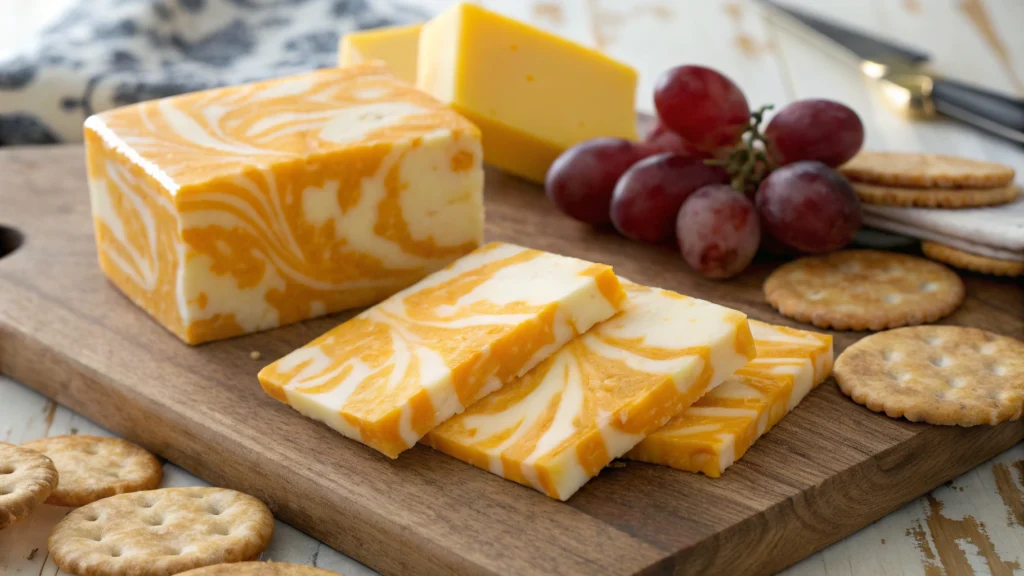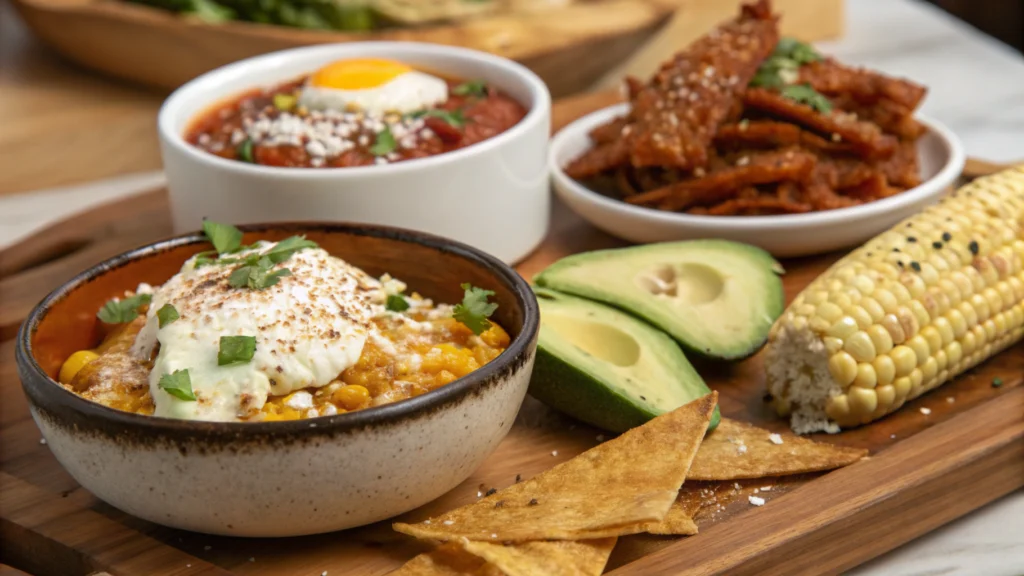
Colby Jack cheese, with its distinctive marbled appearance of orange and white, has become a staple in American households. This semi-soft cheese offers a mild, creamy flavor that appeals to cheese lovers of all ages. Whether melted in a grilled cheese sandwich, sprinkled over nachos, or enjoyed on a cheese board, Colby Jack stands out as one of America’s most beloved cheese varieties.
What is Colby Jack Cheese?
Colby Jack cheese, also known as Co-Jack, is a marbled cheese created by blending two American originals: Colby and Monterey Jack. The distinctive orange and white appearance comes from combining the annatto-colored Colby with the creamy white Monterey Jack. This semi-soft cheese has a higher moisture content than many aged cheeses, giving it a smooth, creamy texture that makes it excellent for both snacking and cooking.
The cheese typically contains about 30% fat content and undergoes minimal aging, usually just a few weeks. This shorter aging process contributes to its mild flavor profile and slightly springy texture which differentiates it from longer-aged cheeses that develop sharper flavors and firmer textures.
Origin and History of Colby Jack Cheese
The story of Colby Jack begins with its parent cheeses. Colby cheese was first developed in 1885 in the small town of Colby, Wisconsin by Joseph F. Steinwand. He created a new cheese-making process that washed the curds with cold water before pressing them, resulting in a softer, moister cheese than cheddar.
Monterey Jack, the other half of this beloved combination, originated in California in the 18th century, developed by Franciscan friars and later commercialized by businessman David Jack, hence the name.
The brilliant idea to combine these two American originals happened in the 1970s when cheese manufacturers realized that blending the two varieties created a visually appealing and flavorful product. Since then, Colby Jack has grown to become one of the most popular cheese varieties in the United States, representing a true American innovation in the dairy industry.
Colby Jack Cheese Taste
Colby Jack offers a mild, buttery flavor with a slight tanginess from the Monterey Jack component. It’s less sharp than cheddar but more flavorful than mozzarella, striking a perfect balance that appeals to a wide range of palates. The taste is often described as:
- Mild and approachable
- Creamy with a slight buttery note
- Subtly sweet
- Slightly tangy finish
- Less acidic than cheddar
Its texture is semi-soft and slightly springy, with a pleasant melt-in-your-mouth quality. When aged, it can develop slightly more complex notes, but it generally maintains its mild character, making it especially popular with children and those who prefer gentler cheese flavors.
🧪 How is Colby Jack Cheese Made?
The production of Colby Jack involves a fascinating process that combines traditional cheese-making techniques with a marbling method unique to this variety:
- Milk Preparation: The process begins with pasteurized cow’s milk, which is heated to a specific temperature.
- Separate Cheese Production: Colby and Monterey Jack curds are prepared separately. For Colby, annatto (a natural food coloring) is added to achieve its characteristic orange hue.
- Curd Formation: Rennet and bacterial cultures are added to coagulate the milk into curds.
- Washing Process: A key step for Colby is washing the curds with cold water, which replaces some of the whey and reduces the acidity, resulting in a softer texture than cheddar.
- Marbling Technique: The Colby and Monterey Jack curds are combined in a marbling pattern. Unlike some marbled cheeses where different milks are used, Colby Jack’s distinctive look comes from the annatto coloring in the Colby portion.
- Pressing and Aging: The combined curds are pressed into molds to form blocks or wheels and then aged. Colby Jack typically undergoes minimal aging—usually just a few weeks—which contributes to its mild flavor and semi-soft texture.
This production method creates the signature marbled appearance that makes Colby Jack instantly recognizable in the cheese aisle.
🍽️ What is Colby Jack Cheese Used For?
Thanks to its mild flavor and excellent melting properties, Colby Jack is one of the most versatile cheeses in the kitchen:
Culinary Uses:
- Melting Applications: Perfect for grilled cheese sandwiches, quesadillas, and burgers
- Mexican-Inspired Dishes: Widely used in nachos, enchiladas, and tacos
- Casseroles and Baked Dishes: Adds creaminess and mild flavor to pasta bakes and potato dishes
- Cold Applications: Excellent on sandwiches, wraps, and salads
- Cheese Boards: Provides a mild option that appeals to most palates
- Snacking: Often cut into cubes or sticks for a quick protein-rich snack
Best Pairings:
- Fruits: Apples, grapes, and pears
- Crackers and Bread: Works well with nearly any variety
- Meats: Ham, turkey, and roast beef
- Wines: Light reds like Pinot Noir or crisp whites like Sauvignon Blanc
- Beers: American lagers and wheat beers complement its mild flavor
Is Eating Colby Jack Cheese Good for You?
When consumed as part of a balanced diet, Colby Jack cheese offers several nutritional benefits:
Colby Jack provides significant amounts of calcium, with a one-ounce serving delivering approximately 20% of the daily recommended intake. According to the National Dairy Council, this makes it an excellent food for building and maintaining bone health (National Dairy Council).
Research from the Journal of the American College of Nutrition suggests that moderate cheese consumption may actually support heart health despite its saturated fat content, likely due to its calcium content and bioactive peptides (JACN).
However, Colby Jack is relatively high in sodium and fat, so moderation is key. The American Heart Association recommends limiting saturated fat intake, including those from cheese (AHA).
What Are the Benefits of Colby Jack Cheese?
Colby Jack offers several nutritional advantages that make it more than just a tasty addition to your meals:
High-Quality Protein Source: Contains all essential amino acids, with about 7 grams of protein per ounce. According to the Journal of Nutrition, dairy proteins are considered complete proteins essential for muscle maintenance and growth.
Calcium Powerhouse: Provides approximately 20% of daily calcium needs per ounce, supporting bone health. The National Institutes of Health confirms calcium’s critical role in preventing osteoporosis.
Vitamin Content: Contains vitamins A, B12, and riboflavin, which support vision, nervous system function, and cell metabolism. Harvard Health Publishing emphasizes these vitamins’ importance in overall health maintenance.
Mineral-Rich: Provides phosphorus, zinc, and selenium, which support numerous bodily functions including immune response. The American Journal of Clinical Nutrition highlights these minerals’ essential roles in biochemical processes.
Conjugated Linoleic Acid (CLA): Contains CLA, which some studies suggest may have anti-inflammatory properties. Research in the Journal of Dairy Science indicates potential health benefits from this dairy fat component.
Satiety Factor: The combination of protein and fat helps promote feelings of fullness, potentially aiding in appetite control. The International Journal of Obesity has published research supporting dairy’s role in satiety.
Probiotic Potential: Like many cheeses, may contain beneficial bacteria that support gut health, though levels vary. The American Gut Project research highlights connections between fermented foods and microbiome health.
Colby Jack Cheese Similars:
- Cheddar-Jack: Another blended cheese combining cheddar and Monterey Jack
- Pepper Jack: Monterey Jack with added peppers and spices; similar texture with a spicy kick
- Mild Cheddar: Similar meltability and versatility, though lacking the marbled appearance
- Edam: Comparable mild flavor and semi-soft texture
- Havarti: Shares a creamy texture and mild flavor profile
Colby Jack Cheese vs Cheddar
When choosing between Colby Jack and cheddar, understanding their differences can help you select the right cheese for your needs:
| Characteristic | Colby Jack | Cheddar |
|---|---|---|
| Appearance | Marbled orange and white | Solid yellow/orange |
| Texture | Semi-soft, springy | Firm, becoming crumbly when aged |
| Moisture Content | Higher | Lower |
| Flavor | Mild, slightly sweet, buttery | Ranges from mild to sharp depending on age |
| Aging Time | Minimal (weeks) | 3-24+ months |
| Melting Quality | Excellent, smooth | Good, can become oily if aged |
| Fat Content | Similar (approximately 30%) | Similar (approximately 30-35%) |
| Best Uses | Mexican dishes, sandwiches, snacking | Wider range from melting to grating |
| Origin | American (1970s) | English (12th century) |
The main difference lies in the production process: Colby (half of Colby Jack) undergoes a curd-washing step that cheddar doesn’t, resulting in a softer texture and milder flavor profile.
Famous Recipes Using Colby Jack Cheese
Colby Jack’s versatility shines in these popular recipes:
- Ultimate Grilled Cheese: Butter two slices of sourdough bread, layer with thick-cut Colby Jack, and grill until golden and melty. The blend of Colby and Jack creates the perfect melt and flavor.
- Tex-Mex Queso Dip: Melt Colby Jack with a splash of milk, diced tomatoes, green chilies, and a touch of cumin for an irresistible dip that stays smooth and creamy.
- Loaded Potato Skins: Top baked potato halves with crumbled bacon, Colby Jack, green onions, and a dollop of sour cream for a crowd-pleasing appetizer.
- Southwest Chicken Casserole: Layer tortillas, shredded chicken, black beans, corn, enchilada sauce, and plenty of Colby Jack for a family-favorite dinner.
- Colby Jack Stuffed Burgers: Create burger patties with a core of Colby Jack cheese that melts into a molten center when cooked.
- Breakfast Egg Muffins: Mix eggs with diced peppers, onions, and Colby Jack, then bake in muffin tins for grab-and-go breakfast options.
- Cheesy Broccoli Soup: Use Colby Jack as the primary cheese in this classic comfort soup for a smoother, less sharp flavor than traditional cheddar versions.
10 FAQs About Colby Jack Cheese
- Is Colby Jack cheese lactose-free? No, Colby Jack contains lactose, though in lower amounts than milk. Those with severe lactose intolerance should consume it cautiously.
- Can you freeze Colby Jack cheese? Yes, though it may affect the texture. Securely seal in cling film and store in a zip-top freezer bag. Best used for cooking after freezing.
- How long does Colby Jack cheese last in the refrigerator? Properly stored in plastic wrap or wax paper, it typically lasts 3-4 weeks. Check for mold or unusual odors before consuming.
- Is Colby Jack vegetarian? Most commercial Colby Jack is made with animal rennet and is not vegetarian. Look for specifically labeled vegetarian versions made with microbial rennet.
- Why does Colby Jack have an orange color? The orange color in the Colby portion comes from annatto, a natural plant-based food coloring derived from the seeds of the achiote tree.
- What wine pairs best with Colby Jack cheese? Light to medium-bodied wines work well—try Pinot Noir, Merlot, or Sauvignon Blanc.
- Can I use Colby Jack in mac and cheese? Absolutely! Its excellent melting properties and mild flavor make it ideal for mac and cheese, especially for picky eaters.
- Is Colby Jack gluten-free? Plain Colby Jack cheese is naturally gluten-free. However, some flavored varieties might contain additives with gluten, so always check labels.
- How does Colby Jack differ from Marble Jack cheese? They’re essentially the same cheese. “Marble Jack” is sometimes used as an alternative name for Colby Jack.
- Can I use Colby Jack in Mexican recipes? Yes, it works excellently in Mexican and Tex-Mex dishes, though it’s not traditionally Mexican. Its good melting properties make it perfect for quesadillas, nachos, and enchiladas.
Related

